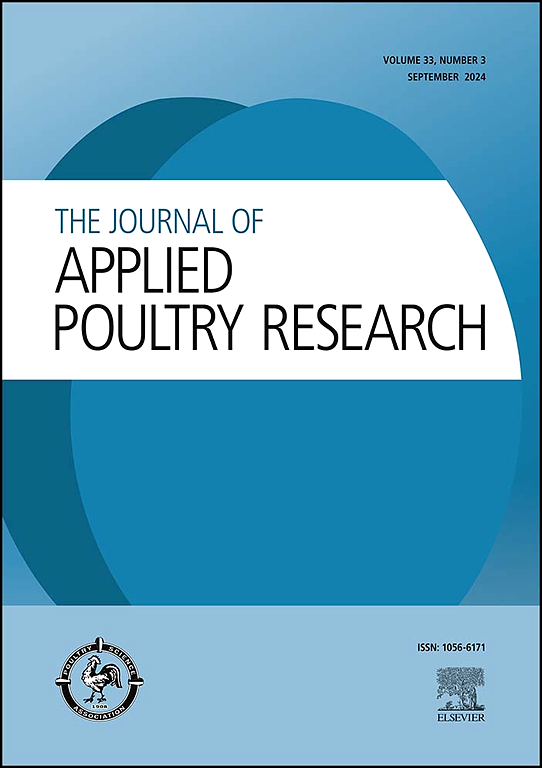饲粮中添加甘油对育成期日本鹌鹑生长性能、肉品质和血液生化的影响
IF 2
3区 农林科学
Q2 AGRICULTURE, DAIRY & ANIMAL SCIENCE
引用次数: 0
摘要
粗甘油(CG)是生物柴油生产的一种副产品,已被证明具有作为能源的潜力,并可作为家禽日粮中的一种新成分。本试验旨在评价饲粮中添加CG对日本鹌鹑生长性能、胴体性状、肉品质和血液参数的影响。采用完全随机设计(CRD),将375只1日龄鹌鹑随机分为5种饲粮处理。每个处理重复5次,每个重复15只鸟。试验饮食包括不同水平的CG(0%、3%、6%、9%和12%)。在基础日粮中加入甘油。评估采食量、增重和饲料系数等参数,以评估CG对生长性能的影响。此外,还分析了胴体性状(如胴体产量、胸围产量、大腿产量、肝重、砂囊重和心脏重)和肉质指标(如解冻损失和滴漏损失),以确定CG对肉品质的影响。还测量了CG对血清生化参数(如血清总蛋白、白蛋白、球蛋白、葡萄糖、胆固醇、甘油三酯和尿酸)的潜在影响,以评估鸟类的健康和代谢状况。采用CRD下的单因素方差分析对数据进行统计评价,在5%显著性水平上采用Duncan多重极差检验比较治疗手段。本研究结果表明,与较低甘油水平和对照组相比,饲粮中添加12% CG显著提高了生长性能,提高了采食量、增重和饲料系数。饲喂12% CG的禽类胴体产量也较高(P <;0.05),但其他胴体性状,如乳房产量、大腿产量、肝脏重量、砂囊重量或心脏重量未受影响。肉质分析显示,加入12%的CG可以减少解冻损失,但对滴漏损失没有显著影响。血液分析显示,对照组的血清总蛋白水平明显高于9%甘油组,而血清葡萄糖水平则高于12%甘油组。其他参数,包括血清白蛋白、球蛋白、胆固醇、甘油三酯和尿酸,不受饮食治疗的显著影响。综上所述,饲粮中添加12% CG可提高生长性能、胴体产量和部分肉质性状,但不会对血液指标产生不利影响。本文章由计算机程序翻译,如有差异,请以英文原文为准。
Effect of dietary supplementation of glycerin on growth performance, meat quality, and blood biochemistry of growing Japanese quails (Coturnix coturnix japonica)
Crude glycerin (CG), a by-product of biodiesel production, has demonstrated potential as an energy source and could serve as a novel ingredient in poultry diets. This study aimed to evaluate the impact of CG supplementation on growth performance, carcass traits, meat quality, and blood parameters in Japanese quails. A total of 375 one-day-old quails were randomly assigned to five dietary treatments in a completely randomized design (CRD). Each treatment was replicated five times, with 15 birds per replicate. The experimental diets included varying levels of CG (0 %, 3 %, 6 %, 9 %, and 12 %). Glycerin was incorporated into the basal diet. Parameters such as feed intake, weight gain, and feed conversion ratio were assessed to gauge the impact of CG on growth performance. Additionally, carcass traits (e.g., carcass yield, breast yield, thigh yield, liver weight, gizzard weight, and heart weight) and meat quality indicators (e.g., thawing loss and drip loss) were analyzed to determine the influence of CG on meat production and quality. The potential effect of CG on the serum biochemical parameters (e.g., serum total protein, albumin, globulin, glucose, cholesterol, triglycerides, and uric acid) was also measured to assess the health and metabolic status of the birds. Data were statistically evaluated using one-way ANOVA under CRD, and treatment means were compared using Duncan's multiple range test at a 5 % significance level. The results of this study demonstrated that the dietary inclusion of 12 % CG significantly enhanced growth performance, as evidenced by increased feed intake, weight gain, and improved feed conversion ratio compared to the lower glycerin levels and control group. Birds fed 12 % CG also had higher carcass yield (P < 0.05), though other carcass traits, such as breast yield, thigh yield, liver weight, gizzard weight, or heart weight, remained unaffected. Meat quality analysis revealed that the inclusion of 12 % CG reduced thawing loss without significantly affecting drip loss. Blood profile analysis showed that the control group had significantly higher serum total protein levels than the 9 % glycerin group, while serum glucose levels were higher in the control group compared to the 12 % CG group. Other parameters, including serum albumin, globulin, cholesterol, triglycerides, and uric acid, were not significantly affected by dietary treatments. In conclusion, 12 % CG supplementation enhanced growth performance, carcass yield, and some meat quality traits without adversely affecting blood profile indicators.
求助全文
通过发布文献求助,成功后即可免费获取论文全文。
去求助
来源期刊

Journal of Applied Poultry Research
农林科学-奶制品与动物科学
CiteScore
4.10
自引率
10.50%
发文量
80
审稿时长
104 days
期刊介绍:
The Journal of Applied Poultry Research (JAPR) publishes original research reports, field reports, and reviews on breeding, hatching, health and disease, layer management, meat bird processing and products, meat bird management, microbiology, food safety, nutrition, environment, sanitation, welfare, and economics. As of January 2020, JAPR will become an Open Access journal with no subscription charges, meaning authors who publish here can make their research immediately, permanently, and freely accessible worldwide while retaining copyright to their work. Papers submitted for publication after October 1, 2019 will be published as Open Access papers.
The readers of JAPR are in education, extension, industry, and government, including research, teaching, administration, veterinary medicine, management, production, quality assurance, product development, and technical services. Nutritionists, breeder flock supervisors, production managers, microbiologists, laboratory personnel, food safety and sanitation managers, poultry processing managers, feed manufacturers, and egg producers use JAPR to keep up with current applied poultry research.
 求助内容:
求助内容: 应助结果提醒方式:
应助结果提醒方式:


